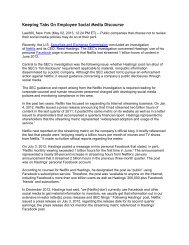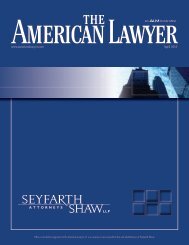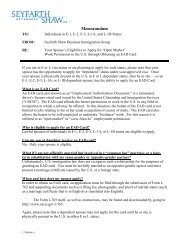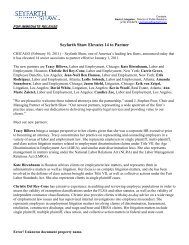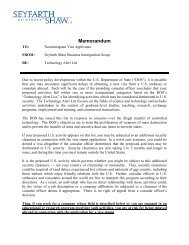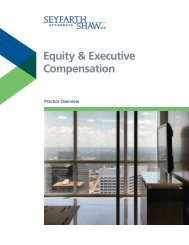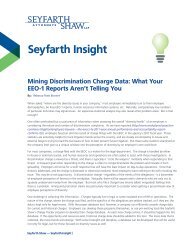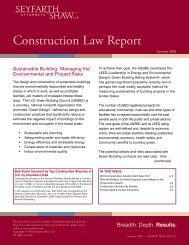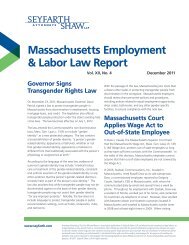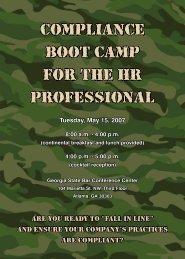Litigating California Wage & Hour and Labor Code Class Actions
Litigating California Wage & Hour and Labor Code Class Actions
Litigating California Wage & Hour and Labor Code Class Actions
You also want an ePaper? Increase the reach of your titles
YUMPU automatically turns print PDFs into web optimized ePapers that Google loves.
nothing but still are bound by the class release. Those class members who do not request<br />
exclusion will also have the option of filing an objection to the settlement. 472<br />
After a fixed period following the issuance of notice (usually 45-60 days), the claims period<br />
will end, <strong>and</strong> class counsel will seek final approval of the settlement. Above <strong>and</strong> beyond<br />
the analysis the court conducted at preliminary approval, the court will examine the extent<br />
of class participation in the settlement, will rule on any objections, <strong>and</strong> will make final<br />
determinations as to class counsel’s request for attorney’s fees <strong>and</strong> an incentive payment<br />
or “enhancement” for the class representative (additional money beyond that received by<br />
other class members as a reward for taking the risk of filing the class action).<br />
When <strong>Labor</strong> <strong>Code</strong> class actions were relatively novel, there was little consistency between<br />
different judges as to the scrutiny of settlements they would undertake or the rules they<br />
would apply. Most courts who did not have much experience with class actions typically<br />
undertook very little scrutiny of class settlements beyond ensuring that they were not<br />
collusive <strong>and</strong> that the notice provided clear instruction to the class. Over the intervening<br />
years, however, a substantial body of law has developed to provide courts with better<br />
guidance as to how to evaluate class settlements in wage <strong>and</strong> hour cases.<br />
B. Restrictions on Reversions of Settlement Funds<br />
Most class settlements are the product of mediation. Unlike a court, which must protect the<br />
interests of a class, a mediator seeks solely to broker a settlement acceptable to the parties<br />
who hired the mediator—i.e., the lawyers for the parties. Irrespective of their fealty to<br />
ethical obligations, plaintiffs’ counsel—who often have near absolute control over<br />
wage/hour class litigation—have a financial interest in maximizing the attorney’s fees they<br />
will receive through the settlement. The employers’ financial incentive is to achieve as<br />
broad of a release as possible for as little money as possible. Because the plaintiff’s lawyer<br />
typically receives an attorney’s fee that is a percentage on the gross value of the class<br />
settlement, employers would commonly agree to a nominally larger gross settlement value<br />
on the condition that any unclaimed settlement funds be returned to the employer. These<br />
sort of “reversionary” settlements have been popular because they allowed an employer<br />
the possibility of paying substantially less in settlement than the gross settlement would<br />
suggest, particularly in industries where the employer could predict that the claims rate<br />
would be low.<br />
472<br />
See generally Wershba v. Apple Computer, Inc., 91 Cal. App. 4th 224, 251-52 (2001) (explaining different choices class<br />
members typically have upon receiving class notice). Recent case law also implies that it may be permissible to settle a<br />
certified class action through the acceptance of an offer of judgment by the class representative. See Nelson v.<br />
Pearson Ford Co., 186 Cal. App. 4th 983, 1024-26 (2010) (assuming without deciding that a valid <strong>California</strong> <strong>Code</strong> of<br />
Civil Procedure § 998 offer can be made in a certified class action). Should this process be used, after acceptance, the<br />
parties would then provide class notice, etc., just as if a stipulation of settlement had been entered.<br />
Seyfarth Shaw LLP | www.seyfarth.com <strong>Litigating</strong> <strong>California</strong> <strong>Wage</strong> & <strong>Hour</strong> <strong>Class</strong> <strong>Actions</strong> (12th Edition) 103



